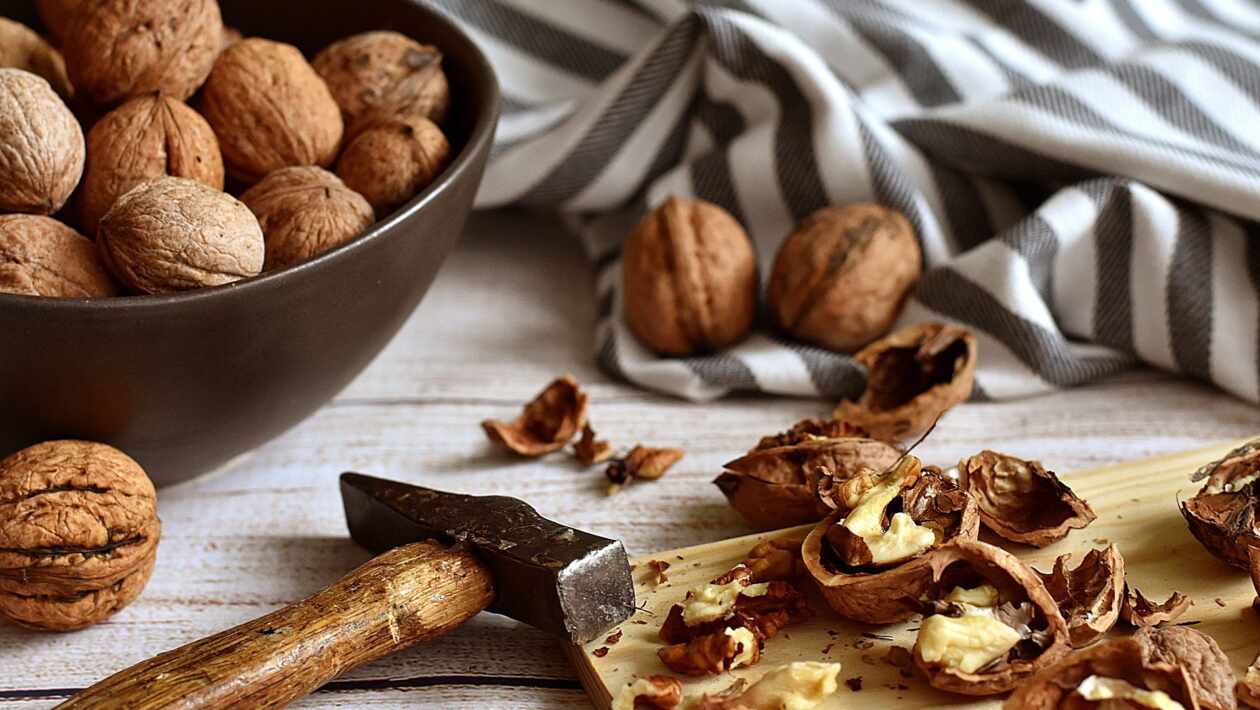Walnut comes from the trees of the genus Juglans. These nuts look like the seeds of a drupe but are edible. It is the exact opposite of a botanical nut, although it is commonly consumed as a nut. You can extract walnuts nutrition by eating it as a snack. You need to break the shells open and eat what’s inside.
Table of Contents
Features of walnuts
Here are some of the features of walnuts:
Fruit
Walnuts are a type of single-seeded stone fruit, and round in shape. They are consumed after they ripen fully. After the walnut has ripened fully, the walnut’s wrinkly shell comes up if you remove the husk. The walnut shell is generally found in two segments, but sometimes there can be more than two segments.
During the ripening process, the husk of the walnut becomes brittle. Moreover, this is the same time when the shell becomes hard. The shell encloses the meat or the kennel and creates two halves separated with like a partition.
The kernels of those seeds are generally found as shelled walnuts, remains covered with the help of a seed coat, which is brown and full of anti-oxidants. These anti-oxidants help protect the seed. The seed is rich in oil due to oxygen and prevents rancidity.
Fact: Walnuts nutrition includes lots of antioxidants due to this and keeps our gut health happy.
Walnuts generally grow late, not until spring passes halfway. The walnut trees often secrete various chemicals into the soil, which helps prevent any other competitive vegetation. For this reason, walnut plantation should be away from vegetable gardens or flower beds.
Tree
A significant attribute of this tree is its profoundly wrinkled, dark bark. Trees go in the range from 70-150 feet and have a distance across 2-4 feet. The compound leaves are somewhere in the range of 1 and 2 feet in length. This tree is valued for its excellent wood, and the delectable nuts eagerly gathered in the pre-winter.
Walnut is without question the best wood on the planet. Our progenitors searched it out and utilized the luxuriousness in their homes, stables, and fences. The warm earthy colored wood completes it perfectly.

How does a walnut tree look?
Essentially everybody perceives a walnut tree when the nuts are on it. Their unmistakable shape, example, and smell are difficult to miss. The stain the structures left on your skin when you hull the walnuts is difficult to get off. Pioneers utilized this to color their fabric. There are other unmistakable qualities to distinguish the tree in different seasons, and during those ages, it is too youthful to even think about bearing natural products or fruit. A definite technique is to slice through a twig at a point and check the essence.
This essence is chambered to some degree, like a honeycomb. Just butternuts and black walnuts contain piths of this nature. Walnut essence, or the pith, is earthy colored and butternut is buff shaded. The huge leaf scars on the twigs, the exposed buds (without any scales spreading on the embryonic leaves), and the twigs and bark’s essence are other simple approaches to distinguish it.
Fact: The richness of omega-3s is one of the walnuts nutrition, making it a must addition to your diet.
Uses of walnut trees
Walnut tree barks make top-notch logs. Cuts of wood 1/28th of an inch thick are stuck to less expensive woods to make it economically workable and purchasable. Most people buy pecan furniture and framing from walnut barks.
Both the veneered and bulk works well for furnishings. Its quality, dependability, and excellence make it perfect for gunstocks. Pecans and Hickories are kind of like first cousins to walnuts.
Walnuts develop in an assortment of soils. It grows best on the profound, all around depleted soils of north Missouri and alluvial soils in the south. It usually happens as dissipated trees or in little forests.
Oddly, walnut roots transmit a development hindering synthetic that keeps different trees and plants and even its sort from developing close to it. Bluegrass generally flourishes in the shades of walnut, which is quite light.
Fact: Walnuts nutrition includes warding off inflammation issues.
It ought to be sufficient to have a tree with great quality wood. Although walnuts have a twofold worth, over a million dollars is paid every year, especially for those nuts. The lavishly flavored nut meats or kennels are utilized by cooks, treats, and frozen yogurt producers. The utilizations go significantly further. The hard shells are utilized as adornments and pounded; the areas used to bore oil wells, clean stream motors, and make activated carbon (a sort of modern charcoal used in an assortment of ways).
Types of walnuts
The major two species of walnut grown for their seeds; English walnut and the black walnut. The flavor percentage of black walnuts is quite high due to the hard shell. Also, the black walnut’s poor hulling leads to deficient production of these types of nuts. Several hybrids, commonly known as walnut cultivars, were developed commercially, but there are usually from the English walnut variant. There are also other kinds of species, such as J. California California is from the southern part of California, while the J.hindsil or Juglans californica hindsil is from the Northern part of California.

Walnuts nutrition facts
To say walnuts is a nutritional food can just be an understatement. Walnuts give fibers, healthy fats, minerals, and vitamins. Moreover, this is just the tip on how beneficial it can be towards your health.
Fact: There has been so much interest in this single kind of nut that annually, the University of California has a conference where researchers gather to discuss the latest research regarding walnuts.
Walnuts nutrition: Loaded with Antioxidants
Walnuts have great antioxidant content when compared to other nuts. This aspect comes from the melatonin, vitamin E, and other types of compounds from plants known as polyphenols. These are rich due to the papery like the skin of walnuts.
A study with healthy adults showed that a walnut rich meal could prevent oxidative damage of bad cholesterol LDL. On the other hand, a refined fat meal would do the opposite. This is very beneficial because the oxidized LDL is known to build up in the arteries, leading to atherosclerosis.
Walnuts nutrition: Goodness of Omega 3
Walnuts are an excellent source of Omega-3s. The walnuts can provide up to 2.5 grams per 28 grams or 1 ounce of serving. The Omega-3s fat from the plants, which includes walnuts, is popularly known as alpha-linolenic acid or ALA. This is a significant fat, which signifies that you must receive it from your diet. Based on the Institute of Medicine studies, the sufficient intake of the compound ALA Is about 1.1 to 1.6 grams per day for men and women, respectively. This guideline can be met with just a single serving of walnut. Studies that include observations show that per gram of ALA per day can lower the risk of heart diseases by 10%.
Walnuts nutrition: Cures Inflammation
Inflammation can be regarded as the root of several diseases, including various heart disease, Alzheimer’s, diabetes, and even cancer, which can result in oxidative stress. The presence of polyphenols in the walnuts can help in fighting the oxidative inflammation and stress. Moreover, another smaller group of polyphenols, commonly known as ellagitannins, can also be very much involved. Additionally, the beneficial bacterias present in the guts can help convert ellagitannins into compounds, which were commonly known as urolithins, which have been tending to help reduce inflammation. ALA omega-3 fat, argentine amino acid, and magnesium, which have been present in walnuts, can decrease inflammation.
Walnuts nutrition: Improves Gut health
Several studies show that on the condition that your gut is quite rich in bacteria, which promotes health and various other microbes, this can help in giving you overall good health. Moreover, if the composition of the microbiota is unhealthy, then it can lead to severe disease and inflammation in the guts and even in other parts of the body resulting in a higher risk of obesity, cancer, and heart diseases. The microbiota gets heavily influenced by the consumption of food you do. One of the best ways to keep your gut healthy is by having walnuts.
Walnuts nutrition: Prevents Cancer
Various animals, test tubes, and even human observational studies have helped understand that consumption of walnuts can help reduce the risk of a certain type of cancers, which can include breast, colorectal, and even prostate cancers. It has already been discussed that walnuts are quite rich in the compounds of polyphenol ellagitannins. Some kinds of gut microbes can help convert these microbes to another type of compound called urolithins.
The compound urolithin has many anti-inflammatory characteristics in their guts, which can be regarded as one of the ways or methods where eating walnuts can help prevent cancer. The anti-inflammatory actions of urolithins can also help in the protection against other types of cancers. Moreover, urolithins have several hormones similar to properties, which can prevent hormone receptors in the body. This can help in the prevention or lowering the risk of cancers caused by hormones.
Walnuts nutrition: Aids Weight loss
Another walnut nutritional fact is that it helps in weight control. Walnuts are full of dense calories. But studies done on this show that energy absorbed is much lower; almost 21% compared to other nutrients. Moreover, eating walnuts can help in controlling your appetite.
Other important walnut nutritional facts are that walnuts can help lower the risk of type 2 diabetes, which can quickly help control weights. A lot of weight can result in an increase in blood sugar as well as diabetes.
Final thoughts
Nuts have a perfect amount of fat content; thus, they can quickly become very rancid. The rancid nuts are usually not safe and can have a very sharp flavor that people may find very unpleasant. If you keep walnuts in the shells and very dark and cool places, it can improve their shelf life. If you store nuts in the refrigerators below 40 degrees Fahrenheit, you can keep them good for a year.
Moreover, if you wish to store them at room temperatures, you have first to freeze them. Many researchers do believe that the consumption of walnuts does not lead to any gain of weight. Although walnuts are quite dense in calories, you should consume it moderately to prevent side effects.
Moreover, high walnut consumption can also lead to diarrhea. This can happen after a person consumes many walnuts due to the high content o fiber and oil and, in many cases, also due to increased sensitivity, especially with people having IBS or irritable bowel syndrome. Moreover, the people who are allergic to these nuts should not actually consume walnuts.
In case the person consuming walnut develops a rash or has difficulty breathing, they need immediate medical attention. Children should be given walnut under supervision since they are usually quite big and irregular and can result in choking. Walnuts are a beneficial and excellent addition to the diet as it has a lot of nutritional benefits, as discussed in this article.











